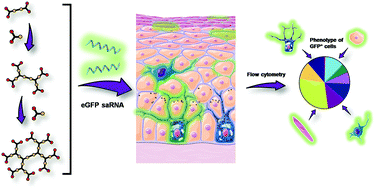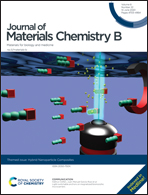Ornithine-derived oligomers and dendrimers for in vitro delivery of DNA and ex vivo transfection of skin cells via saRNA†
Abstract
Gene therapies are undergoing a renaissance, primarily due to their potential for applications in vaccination for infectious diseases and cancers. Although the biology of these technologies is rapidly evolving, delivery strategies need to be improved to overcome the poor pharmacokinetics and cellular transport of nucleic acids whilst maintaining patient safety. In this work, we describe the divergent synthesis of biodegradable cationic dendrimers based on the amino acid ornithine as non-viral gene delivery vectors and evaluate their potential as delivery vectors for DNA and RNA. The dendrimers effectively complexed model nucleic acids at lower N/P ratios than polyethyleneimine and outperformed it in DNA transfection experiments with ratios above 5. Remarkably, all dendrimer polyplexes at N/P = 2 achieved up to 7-fold higher protein content over an optimized PEI formulation when used for transfections with self-amplifying RNA (saRNA). Finally, transfection studies utilizing human skin explants revealed an increase of cells producing protein from 2% with RNA alone to 12% with dendrimer polyplexes, attributed to expression enrichment predominantly in epithelial cells, fibroblasts and leukocytes, with minor enrichment in NK cells, T cells, monocytes, and B cells. Overall, this study indicates the clear potential of ornithine dendrimers as safe and effective delivery vectors for both DNA and RNA therapeutics.

- This article is part of the themed collection: Hybrid Nanoparticle Composites


 Please wait while we load your content...
Please wait while we load your content...